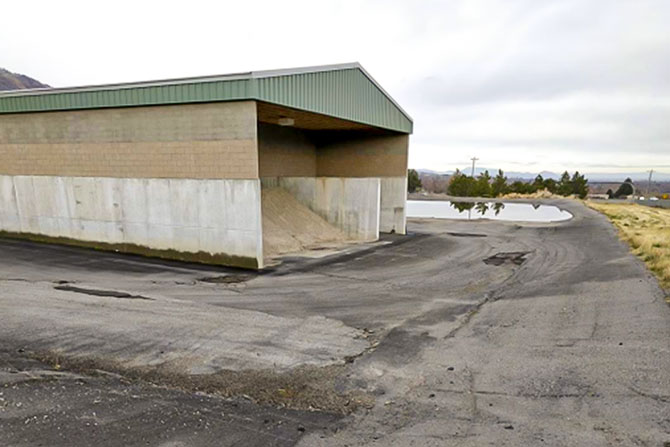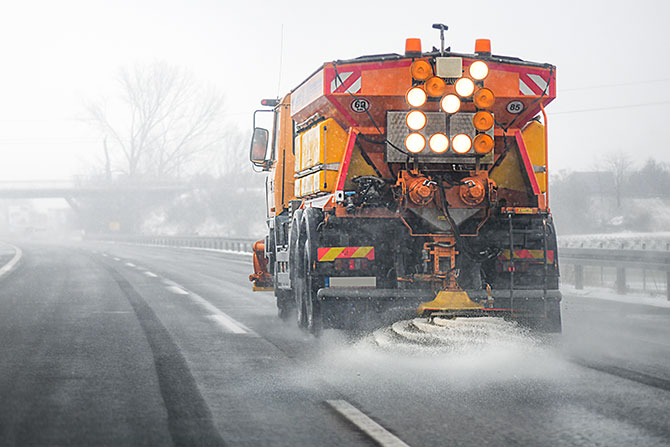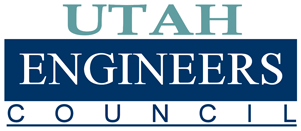The application of brine solution on roadways is a very common and necessary action throughout the State of Utah. The solution, applied prior to or during a storm, effectively prevents any bond between the pavement and the overlying snow and ice. Such a prevention in bonding facilitates easier removal of the snow or ice. The application of a brine solution on the road surface is generally not considered an environmental threat due to the relatively small amount of solution applied and the large amount of dilution from the snow and ice.
Salt storage, however, can pose a significant environmental hazard due to the concentration of salt stored in a relatively small area, as well as other contaminants potentially introduced by the salt distribution equipment and processes. A thorough design of salt storage facilities can be an overlooked aspect of effective maintenance infrastructure. This article will provide a reference for the design of salt storage facilities.
Site Location
When locating a salt storage facility, factors similar to those of emergency services facilities should be considered. Proximity to major transportation routes will allow for quick access to priority motorways during a storm event, as well as allow for easy delivery of salt, fuel and other maintenance supplies. The centralization of the service area should also be considered to provide the quickest access to the entire area. Care should also be given to locate and avoid environmentally sensitive areas. The following list includes some of these environmentally sensitive areas:
- Culinary Water Sources: Source Water Protection Areas should be identified with the help of local municipalities, and the distance from private wells should be considered based on local geology.
- Non-Culinary Wells: Any well can provide access for runoff to contaminate aquifers below ground. The proximity to these wells should be considered based on local geology.
- Storm Water Conveyance Features: Ditches, storm drains and other methods of storm water conveyance could allow for the quick movement of salty runoff from salt storage facilities.
- Surface Water Bodies: Locate facilities outside of the 100-year flood plain of a stream or river and far enough from lakes, wetlands or other water bodies to eliminate any chance of direct discharge.
- Hydrogeologically Sensitive Areas: Areas with unconsolidated aquifers and with shallow, fractured bedrock pose a high risk to groundwater contamination due to easy infiltration to aquifers.
Facility operators should also be aware of local hazards, and operations should be monitored to ensure sensitive areas are not contaminated.
Site Design
Salt should be stored and handled on an impervious pad. This pad should be constructed of the appropriate thickness and reinforcement to reduce the risk of cracking due to the load of the salt pile and the equipment necessary to handle the salt. In the case of construction in sensitive areas or with a pad that is at risk of cracking, an impervious liner should be installed beneath the pad to further reduce the risk of seepage due to imperfections in the pad.
The site should be graded as such to prevent run-on from encountering the salt storage and handling area. A slope of 1-2% percent should suffice to let water drain away from the salt storage pad. If it is impossible to appropriately grade the area sufficiently to avoid run-on from entering the salt storage area, a curb should be installed to direct the flow around the pad. No floor drains should exist in the salt storage area.
Stored salt should always be covered. The practice of covering salt during storage serves many benefits. These benefits include but are not limited to minimizing run-off that can lead to environmental contamination, preventing lumpy salt that can be difficult to use and minimizing salt loss, saving the agency money on materials. Salt can be covered using a permanent or temporary structure, as well as with a tarp.
When designing a salt storage structure, it is important to consider the pervious nature of the walls. In general, the structure should be placed on an impervious pad, with walls impervious to a height of at least one foot above where the pile meets the wall.
The Salt Institute’s Salt Storage Handbook provides a reference for structure design based on the size of required piles (Salt Institute, 2015). As well as providing enough room for salt piles, ideally, a storage structure would allow enough room for the loading, mixing and other handling activities to be performed under cover.

Retention Pond Specifications
As described in previous sections, site grading provides the base for storm water management across the site. Grading should prevent any run-on from contacting stockpiles whether covered by a structure or tarp. Storm water that does not come in contact with salt should be directed away from the site and onto adjacent property or the storm system. Water that does collect salt should be directed to proper containment locations such as a retention or evaporation pond. This is the reason for the importance of attempts to contain as much of the salt storage and handling areas as possible.
Contaminated storm water and wash water should be directed to the pond by means of a collection system. The collection system can consist of ditches, berms, pipes or curbs to isolate the regions contaminated during salt handling procedures. The system should be sized to accommodate a 100-year storm event.
Collection ponds should be constructed with an impermeable synthetic liner to prevent discharge into the ground water. Ideally, collection ponds should be sized to allow enough storage for the pond to act as an evaporation pond. Clean out of the pond should be performed on a regular basis and the spoils disposed of in accordance with Utah Department of Environmental Quality (DEQ) standards.
Conclusion
The conscious development and application of the best management practices contained in this report will improve road clearing efforts while increasing economic, and environmental efficiency.
Several sources were used in the compilation of this report and should be considered where further information is desired. The Salt Institute, can be referenced for many items including the design of structures, size of piles and other technical information. The “Safe and Sustainable Snowfighting Award,” available through the Salt Institute, provides specific checklists for facility managers to assess their operations (Salt Institute, 2017).
References
Goodridge, W., Bellon, W., Gelles, L., Maguire, M. (2018). “UDOT Maintenance Site Detention and Retention Pond Water Report.”
Michigan Department of Environmental Quality. (2007). “Salt and Brine Storage Guidance – For Road Agency Maintenance and Other Facilities.” http://www.michigan.gov/documents/deq/deq-ess-p2tasbulksaltbrineguidance_267024_7.pdf. (Jan. 14, 2018).
Salt Institute. (2017). “Safe and Sustainable Snowfighting Award Application.” (Jan. 15, 2018).
Salt Institute. (2016). “Safe and Sustainable Snowfighting – Snowfighter’s Handbook.” (Jan. 15, 2018).
Salt Institute. (2015). “Safe and Sustainable Salt Storage – Salt Storage Handbook” (Jan. 15, 2018)
State of Ohio, Ohio Water Resources Council, State Coordinating Committee on Ground Water. (2013). “Recommendations for Salt Storage – Guidance for Protecting Ohio’s Water Resources.” http://epa.ohio.gov/portals/35/owrc/SaltStorageGuidance.pdf. (Jan. 15, 2018).
“UDOT Snow Removal” UDOT.UTAH.GOV. Utah Department of Transportation. (30 Jan. 2017).









